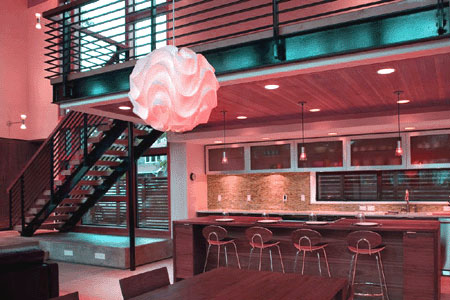
Minimalist home staging is an approach to enhancing the aesthetic appeal of mostly modern properties and is sometimes also used in combination with Asian home staging designs, as well. Minimalism means that there are few design elements used to create the desired look, feel and flow in the home. This translates into a sparse and fundamental interior space which uses the bare minimum of color, furniture, art and accessories to complete the stager’s vision of the ideal floor plan.
I always caution home stagers to use minimalism appropriately, since it can be a very exclusionary design sense for many buyers and fits best in modern condos and modern Asian-inspired spaces with a Zen feel.
This essay centers on the rare use of minimalist design sense in property staging applications.
Minimalist Home Staging Expressions
Going minimalist is rather easy and inexpensive compared to the opposite end of the design spectrum. This is because there is little which must be purchased or rented in order to complete the overall layout. Minimalism is fantastic when used appropriately, since it is a low cost and very DIY-friendly option for modern and ultra-contemporary spaces.
Just remember that if the prospective buyer pool will not embrace a minimal design sense, then you are actually working against yourself when utilizing this particular form of staging technique. I find that minimalism works great in lofts and industrial spaces and is best suited for young upscale urban professionals and artistic types who enjoy putting their unique stamp on a home.
Minimalist Staging Pointers
When using minimalist staging inside your residence, there are a few considerations to keep in mind. Following these general rules will help keep your design balanced and cohesive, while speaking to the basic design sensibilities of your potential buyers or renters:
Minimal means minimal. Never clutter any area. Keep design elements evenly dispersed, so that the overall space is balanced and no one area is completely devoid of furnishings or visually weighted too heavily.
Keep colors incredibly neutral and almost bland, except for accents within the space. Do not use bright colors or primary colors on the walls or floor.
Make sure that every piece of furniture can stand on its own. Pieces should have extreme interest factor and strong lines to allow them to make a bold statement in a minimal space.
Art and accessories should be kept to a few pieces, but should make a huge statement. Select wisely, since the few items chosen must carry the entire space.
Natural materials on the floor and fixtures, such as wood and stone, are perfect complements for a minimalist design. In contrast, ultramodern furniture using plastics, metals and nontraditional materials fit the bill in many spaces.
When using minimalism in an Asian design, think less is more and allow the simplicity of the space to engineer its appeal. Do not rely on overly obvious Asian décor items to do the job, as this will look kitschy.
Minimalist Home Staging Execution
Minimalism is a real risk for any home stager, since the odds of finding a buyer who will embrace this look are low in most markets. These odds can increase if the unit being staged just happens to be a renovated loft in an ultra-modern building in Manhattan, for example.
I would never suggest using minimal design in a standard family residence, as this will likely turn-off far more prospective buyers than it appeals to. For general staging work, think contemporary with universal appeal, but for special clients in particular units which demand a unique perspective, minimalist design may be just the ticket to attract the type of buyer who will really appreciate “something different”.




